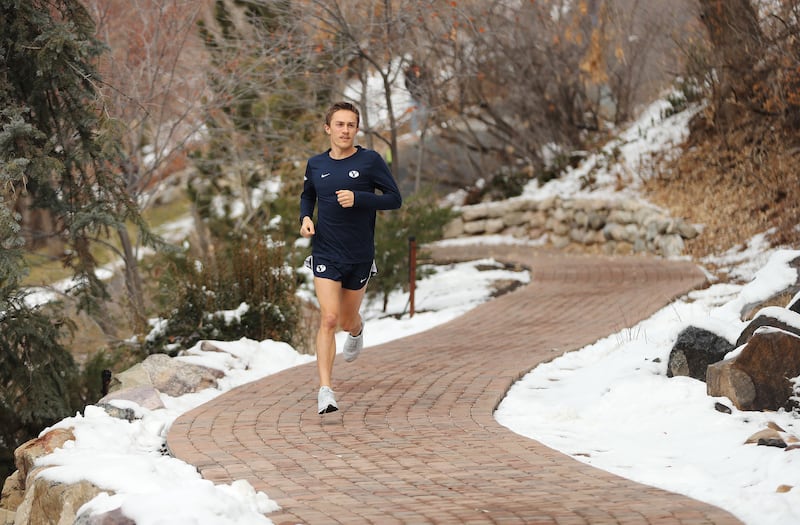His coach calls it the Mantz Pain Chamber, among other things. It’s the place Conner Mantz, BYU’s world-leading distance runner, likes to take his competition. Not content to run with the pack at a more comfortable pace and waiting for a furious last-lap sprint, he goes to the front early and pushes the pace over the duration of the race, dropping runners who can’t handle it. It’s a painful way to race.
“He takes them into the Mantz Zone,” says Ed Eyestone, his coach. “Or the Mantz Pain Chamber. He can handle running a race up front at a high intensity. He has a high tolerance for pain. Either that or he’s too dumb to recognize that’s what’s coming.”
“He takes them into the Mantz Zone. Or the Mantz Pain Chamber. He can handle running a race up front at a high intensity. He has a high tolerance for pain. Either that or he’s too dumb to recognize that’s what’s coming.” — BYU track coach Ed Eyestone on his star runner Conner Mantz
Mantz took all challengers into the Mantz Zone on Feb. 12 in a 5,000-meter race at the University of Washington. Race officials had arranged for a rabbit — a pacesetter — to set the early pace of 65-second laps through 1,200 meters, but even he didn’t want to enter the Mantz Zone, even if only for a few laps.
When the rabbit slowed to 67-second laps, Eyestone yelled to Mantz, “Just go around him!” and Mantz took off. Only teammates Casey Clinger and Brandon Garnica went with him. Mantz continued to hammer the pace and crossed the finish line in 13:28.00 — the fastest time in the world this year by more than nine seconds and six seconds faster than the BYU indoor school record. Clinger and Garnica also were under 13:30 and rank second and third in the world. The threesome — all of them native Utahns — finished 14 ½ seconds ahead of the field.
That makes them strong favorites at next month’s NCAA Indoor Track and Field Championships March 11-13, but they won’t be there. The 2020 NCAA Cross-Country Championships — which was postponed from last November because of the pandemic — will be held two days later. The indoor track and cross-country championships are too close together to allow distance runners enough recovery time to compete in both competitions. Eyestone called the NCAA to complain, noting this will compromise both sports.
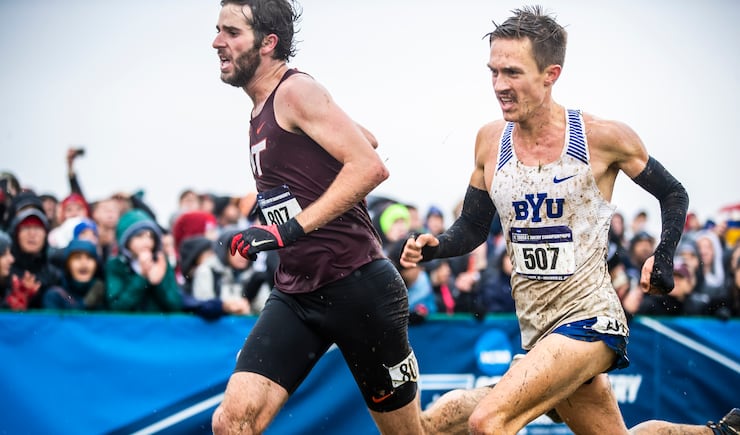
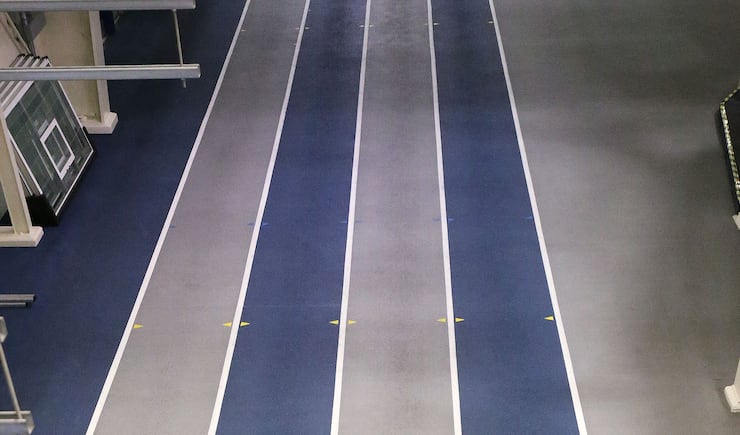
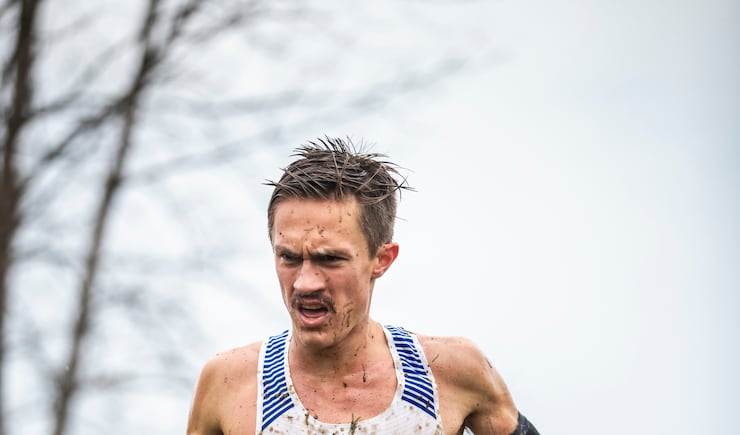
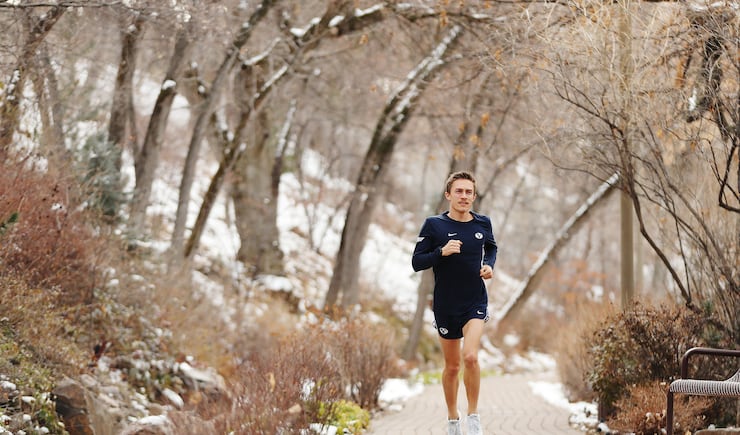

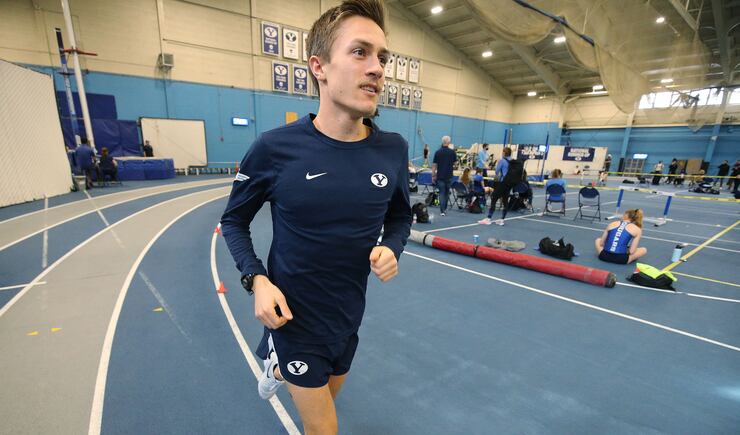
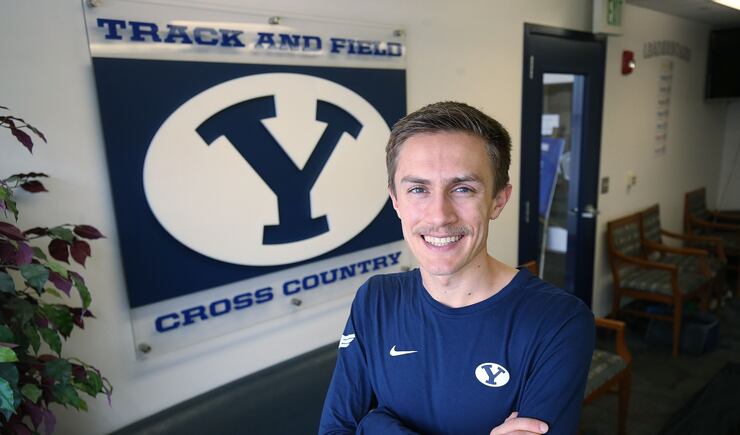
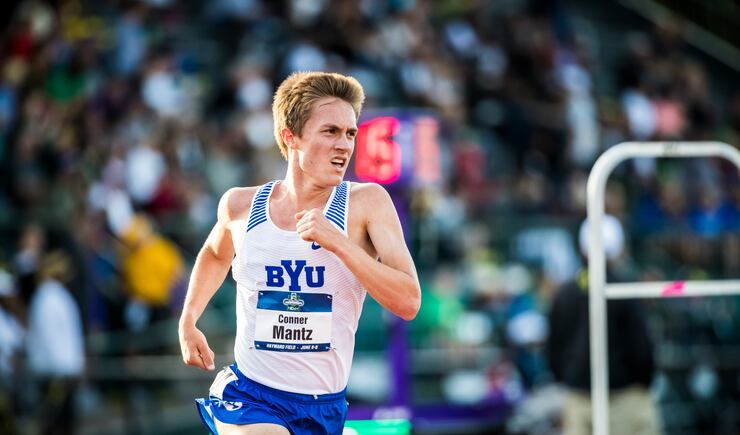
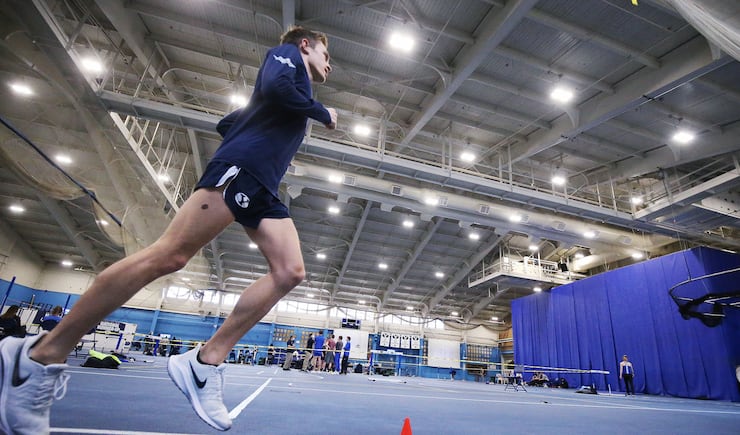
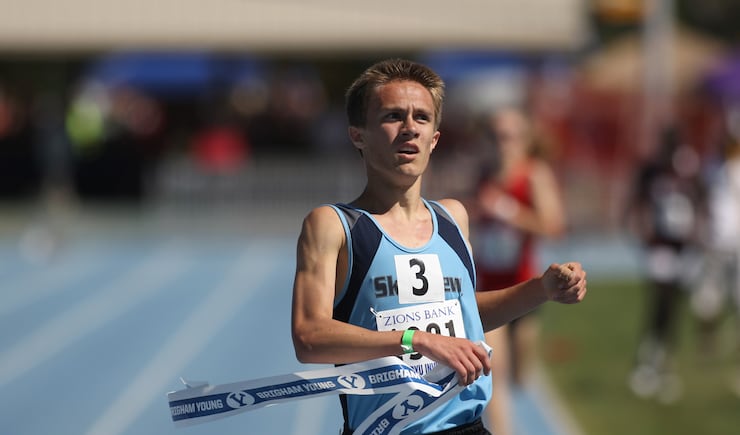
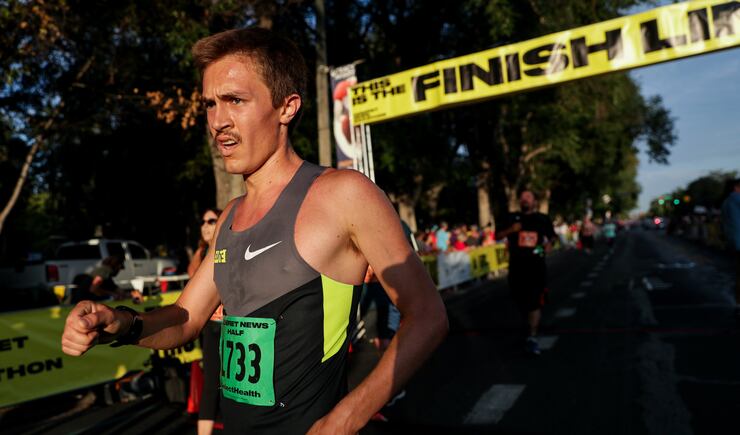
“The good cross-country teams are going to have to choose,” says Eyestone. “They won’t be able to run one of the meets at full strength.”
BYU’s distance runners will not compete in the indoor championships, choosing instead to save their legs for the cross-country championships. The Cougars are the defending NCAA cross-country champions (last held in 2019), and are again ranked No. 1 in the nation. Mantz will be among the favorites in that meet, along with Iowa State’s Wesley Kiptoo and Northern Arizona’s Luis Grijalva.
The Grinder
Ask Eyestone about Mantz and almost the first thing he says is, “He’s a grinder. It’s fun to watch him run because he knows one way to run — just go out and pound it. He likes to be in the front of a race.”
It takes confidence and courage to lead the race at a hot pace for the full distance. Aside from the huge demands on the body, there is a certain vulnerability to running in the lead because it allows other runners to conserve energy drafting off the leader; often the leader gets passed late in the race.
Most distance runners prefer to let others set the pace, which is why you see them slow almost to a jog in the early stages of many races hoping someone else will take the lead. It is also why rabbits are hired. Championship races are notoriously cautious, slow, tactical efforts that end with a late mad dash. A tactical 5,000-meter race thus becomes a 400-meter dash and allows more runners a chance to win who otherwise couldn’t contend.
Mantz believes in making the race “honest” — running hard for the full distance, whether it’s the 10,000 or 5,000. “It’s nice to keep it fast, and not to sit back and wait,” he says. “It’s the spirit of the sport. If I believe in myself, why am I giving everybody a chance (by running slow). Too many like to sit back and keep it comfortable.”
“It’s nice to keep it fast, and not to sit back and wait. It’s the spirit of the sport. If I believe in myself, why am I giving everybody a chance (by running slow). Too many like to sit back and keep it comfortable.” — Conner Mantz
Observers tell him the pain of his races is written in the contortions and grimaces of his face. Eyestone tells him that nobody wears the pain more facially than Mantz. Clearly, he pays the price of his aggressive racing style.
“I’m willing to push through the pain because of my competitive drive — that desire to hit the mark (time) and win and go through the pain rather than be more comfortable and ease it through,” he says. “People underestimate how much pain the body can tolerate. I remember somebody telling me once — and I’ve remembered this a lot — that you get to the point where no matter how much pain you are in that moment you know it’s temporary and the chances of dying from it is none. It doesn’t matter if I’m in pain for that moment. It’s the competition. I’m more concerned about beating the guy ahead of me.”
Even as a freshman, competing against accomplished, veteran runners, if Mantz decided the pace was too slow he’d take the lead and ratchet up the pace. It didn’t always end well. In the NCAA cross-country championships during his freshman season, he led much of the race only to fade to 10th at the finish.
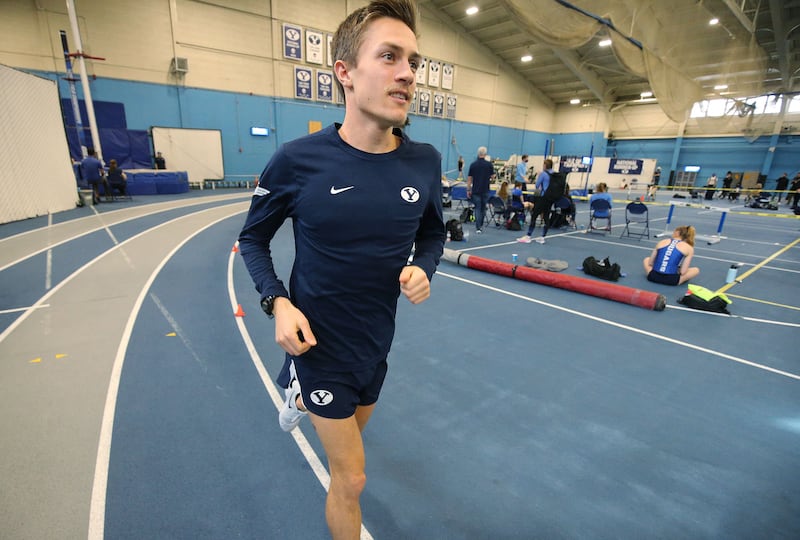
“I told him, ‘You don’t necessarily have to be in the lead as long as you’re in the front pack,’” says Eyestone. “But if the pace is slow he won’t be content with the pack. He’ll go to the front. He feels like that’s an honest race. If you have posers who are up front (slowing the pace), they shouldn’t be there. (Mantz) has been known to weed the pack a little. He’s not afraid. I would even go so far as to say that he enjoys being in front.”
The learning process
As a sophomore, Mantz ran with the lead pack but didn’t take the lead en route to a fourth-place finish in the 10,000-meter run at the 2019 NCAA Outdoor Track and Field Championships (his teammates were first and third), and a few months later he finished third in the NCAA Cross-Country Championships, helping BYU win the team championship.
Mantz, who grew up the northern Utah town of Smithfield (pop. 12,000), was introduced to running by his father, Robert, a former Weber State wrestler who took up marathoning to lose weight. He began riding his bike alongside his father during his training runs on the road. “I saw him running and he loved it,” says the younger Mantz.
After seeing his father and older brother Garrett run a half-marathon, he decided he wanted to try it, but he was only 11 and race officials said he didn’t meet the age limit. A year later, in 2008, he entered his first half-marathon race and finished in 1 hour, 33 minutes, 27 seconds, placing 29th overall. A few months later, still 12, he ran another half-marathon, this one in 1:22:43, good for 49th place.
He was dropping big chunks of time almost every time he raced. On May 15, 2010, at the age of 13, he placed third overall in the Ogden Half-Marathon with a prodigious time of 1:19:17. That same year he won a 5,000-meter race in Blanding and beat the 2A high school state cross-country champion. He was training three to five miles several days a week, with an occasional longer run on weekends.
“It’s an unconventional route,” he says, referring to running long distances at such an age. “I probably would not recommend it, now that I think about it.”
Says Robert Mantz, “He was just having fun. He was doing well, but I didn’t want to pressure him. I just wanted to make sure he was having fun with it. And he never got injured until he was a high school senior.”
Mantz was playing club soccer at the time, but his interest in running was growing. “Everyone told me I’d be good at cross-country,” he says. “I thought they were talking about skiing.” He signed up for the cross-country team as a freshman and took second in the state championships, just a half-second behind the winner. “I was hooked,” he says. “I quit soccer and didn’t look back.”
Mantz won four high school state championships in track and cross-country. He was still in high school when he introduced himself to the national and international running scenes. He competed in the U.S. Junior National Cross-Country Championships, a team reserved for ages 19 and under. Junior teams are usually composed of the older college freshmen, but Mantz won the national meet as an 18-year-old and joined the six-man team that competed in the world junior championships in China, where he placed 29th out of 118 runners.
“That elevated him to superstardom,” says Eyestone. “He went to the top of everyone’s recruiting lists.”
Mantz made campus visits to Oklahoma State, Princeton, Furman and Stanford. Eyestone planned to contact Mantz, as well, but he didn’t have to; Mantz called him. “I love when national-caliber athletes call me,” says Eyestone dryly.
While competing in a couple of international competitions, Mantz was told by other runners that he should sign with BYU so he could train with Eyestone. “Everybody I met knew him or of him,” says Mantz.
Eyestone was America’s best distance runner for years. He was a four-time NCAA champion at BYU and in 1985 set a collegiate record of 27:41.05 in the 10,000 that stood for years (it is still the school record). A two-time Olympic marathoner, he ran professionally until he took the BYU coaching position at the age of 39. Since then he has coached a long list of All-American distance runners, and his last three cross-country teams have finished third, second and first, respectively.
Church mission
Mantz signed with BYU, and then two months after graduating from high school he put his running career on hold to serve a two-year mission for The Church of Jesus Christ of Latter-day Saints in Ghana. He ran a few miles each morning to maintain some degree of fitness, but three miles turned to two miles and two miles turned to zero miles.
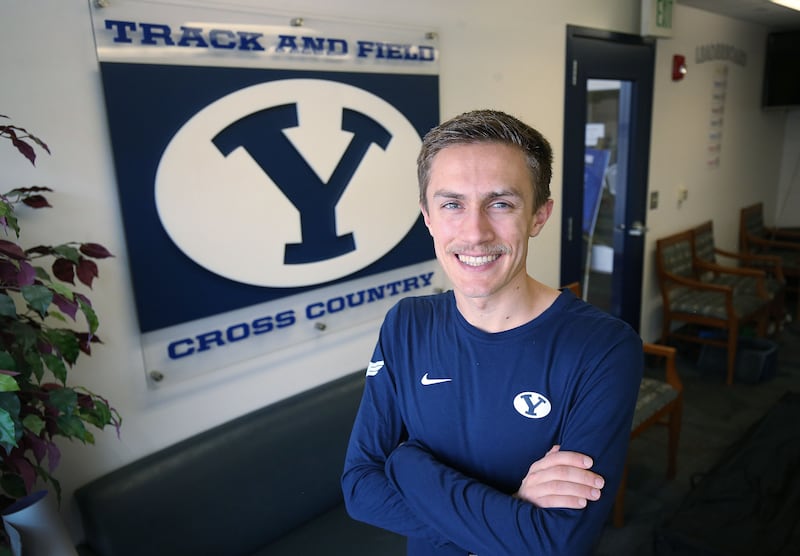
“I was just too busy or my companions didn’t want to run,” he says. “And missionary work is difficult and exhausting. There comes a point when you’re willing to submit to whatever God wants. Whatever he has in store for me will be best.”
Ironically, Mantz gained 30 pounds during the first eight to nine months of his mission while he was running, and then lost most of it after he stopped running. A year after returning from Ghana, he returned to form and produced that 10th-place finish in the NCAA Cross-Country Championships. His improvement has continued since then, but his faith drives him to continue to draw the line at what he is willing to do for training.
“I was just too busy or my companions didn’t want to run. And missionary work is difficult and exhausting. There comes a point when you’re willing to submit to whatever God wants. Whatever he has in store for me will be best.” — Conner Mantz on not running while serving mission
“I’ve always wished I could justify training on Sunday,” he says. “I can’t. I never run on Sunday.” Notwithstanding, he notes there is almost a spiritual dimension to some of his long training runs on the road. “It’s a good time to ponder what’s important and think things through about life,” he says.
Mantz and Eyestone believe his future is in the marathon. He was training for the 2020 U.S. Olympic Marathon Trials when a stress fracture and then the pandemic ended his season.
“He has a great future ahead of him, collegiately and then professionally,” says Eyestone. “His roots were in running the longer distances as a young kid, and he’s put that on the back burner for a while, but when he’s done here he will embrace those roots again. His running style and attitude is suited to the marathon. The marathon is the ultimate grind.”
It is likely Mantz will not use all of his collegiate eligibility (he has two more years remaining after this season) so he can turn professional. Shoe deals — the lifeblood of a pro runner — will probably be waiting for him this spring.
“That will be a conversation coach Eyestone and I will have after the outdoor season,” says Mantz.
Says Eyestone, “I want these guys to take the best offer available. He’s in position to make some money. For now, we have him.”
Olympic dreams
Mantz plans to compete in the U.S. Olympic Track and Field Trials this summer for a berth on the team that will go to Tokyo (the marathon team was decided last year).
“My goal is to make the next Olympic team,” he says. “After that, I don’t know when I’ll do my first marathon. I’ve always seen the marathon as The Distance. When my dad ran them, I thought they were the coolest thing.”
Meanwhile, the Grinder is grinding out tough workouts to prepare for the big races ahead — five-mile runs at 4:40 (per-mile) pace; 10-mile progression runs that start at a six-minute pace and get faster each mile until they reach 4:50 pace; mile repeats on the track at 4:20-4:30 with a four-minute jog recovery between; 10 x 1,000 meters on the track with 60 seconds recovery ....
“He runs the workouts hard,” says Eyestone. “I’m constantly having to hold him back.”
When Mantz isn’t running he’s studying engineering and playing jazz guitar. He plans to attend grad school in mechanical engineering and pursue a career in the medical or energy sectors. “I’m keeping my options open,” he says. “There are lots of interesting possibilities,”
The same could be said for his running career.

